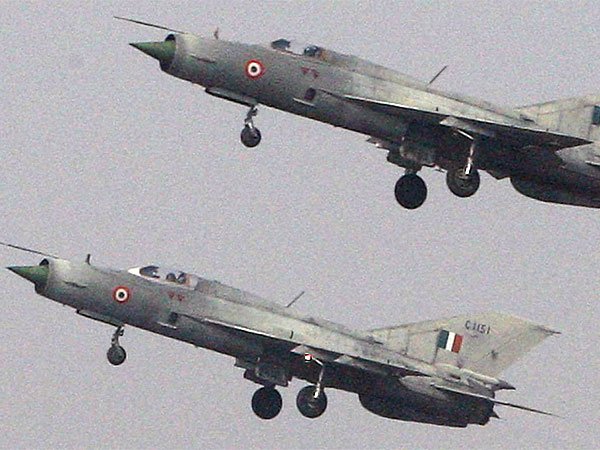Year 1999 C.E. was a unique year in more ways than one. Y2K syndrome had gripped the world with fear and anxiety and every organisation, big or small, was busy downloading and/or taking printouts of entire data base because no one was sure as to what will happen after 23:59:59 on 31st December 1999. Whether the computers will seamlessly switch over to year 2000 C.E. or revert to 1900 C.E. was creating a scare across the globe. Thankfully, the computer software allowed seamless switch over to year 2000 C.E.
For India too, the year 1999 was an extremely significant one, besides the Y2K anxiety and fear. In April 1999, the NDA government led by Shri Atal Bihari Vajpayee, which had come to power in 1998, failed to win a no-trust vote by a single vote, after its coalition partner, the AIADMK withdrew support. The BJP led National Democratic Alliance (NDA), secured 269 votes while the opposition got 270. The opposition under the leadership of Congress’ Sonia Gandhi also failed to come up with the numbers, forcing the dissolution of the House and the holding of fresh elections. Shri Vajpayee remained the “caretaker” Prime Minister until the elections were held. And it was during this period that Pakistan ‘nearly’ succeeded in severing Ladakh region from India by positioning her well-armed soldiers all along Kargil Heights, leading to the Kargil War.
So much has been written about the Kargil War that any further mention would be counterproductive, both from operational as well as record of events point of view. The K. Subhrahmanyam Committee report is the most comprehensive and authoritative information document on this issue.1 However, the most ‘substantive issue’ must be mentioned even at the cost of repetition and that is “Kargil took place because of monumental failure of intelligence agencies” over a period of at least two years preceding Kargil Operations, which commenced on 23May 1999. This paper, will look into certain aspects of the Kargil War, but will focus on the fundamental question whether India is today, two decades later, better placed to face such a contingency.
Army personnel gave an outstanding and exemplary account of bravery and determination while operating in the most inhospitable terrain against an adversary, which had the advantage of position/ location by being at higher ground and vantage point. No army in the world has ever fought a battle at these heights and in such difficult terrain. Kargil War was won not because of superior weapons; it was won due to sheer dint of hard work, exemplary bravery and determination by Indian Army personnel on the ground and Air Warriors in the air. Indian Military was ill-equipped to fight in this terrain – a sad reflection of profligacy in planning for such contingencies by the military planners. Certain fundamental issue that merits attention, with respect to the employment of Air Power, are discussed in the succeeding paragraphs.
Target Location: Unlike plains, where even a camouflaged target can be easily acquired, target in the hills, specially bunkers etc present a vastly different picture. Natural camouflage is inherent nature of a target in the hills. Spotting a bunker opening is well-nigh impossible even from 2 km. Target dimensions are small which further add to the complexity of detection. Target location information, therefore, has to be absolutely precise, may be with an error of no more than few meters. Meandering valleys and high hill features on either side of the direction of attack create severe limitation in spotting and tracking the target before weapon delivery.
Target Illumination: One of the most effective ways of successful hit on the target is illumination by laser (ground/air based) and/or by smoke indicators by ground forces. Smoke indicators, however, do not provide pin point accuracy for guidance. Laser illumination is the most precise method of target illumination.
Factors Affecting Target Identification: Problems created due to natural camouflage, angle of the sun at the time of attack, shadow of adjoining hill on the target, presence of ‘significant cloud’ at or near point of weapon launch, deception by enemy by painting ‘doors/windows outline’ near actual target creates enormous problems for the pilot in spotting, tracking and finally delivering weapon on the target.
Target Destruction/Neutralisation: Only a ‘Direct Hit’ can result in target destruction/neutralisation. There are two reasons. Firstly, in hilly terrain such as in Kargil region, a miss by ten meters will almost certainly mean an unsuccessful weapon delivery. Secondly, the blast effect damage is not as much as in case of target in plains. Error margin, therefore, is almost negligible.
Reconnaissance: Conventional photo reconnaissance even from ultra-low level may not provide accurate information, which would be sufficient for targeting. Visual reconnaissance from vantage point around the hill feature and/or specific heliborne mission for reconnaissance is the only option. However, it must be categorically stated that heliborne reconnaissance will have to take into account enormous threat from man portable Surface to Air Missiles (SAM) and hand held weapons. In fact, infrared (IR) reconnaissance by night might produce better results and may be more helpful in pin-pointing bunker location. Power supply in all bunkers is invariably dependent on small portable generators. Even a one kilo-watt portable generator emits significant heat signature, which can be picked up by the IR pod of reconnaissance aircraft. Superimposing the heat signature thus obtained on IR film on the area map will clearly indicate the location of heat source, the bunker. Humint (human intelligence), however, remains the most important source of actual target location.
Let us now examine the means to engage targets in the hilly terrain such as Kargil.
Fighter Aircraft: A fighter/bomber carrying conventional rockets/bombs has extremely little chance of successfully engaging a target in hills such as a bunker and/or gun position. A successful hit, if at all, is more by stroke of luck than precise aiming. A free fall weapon and/or unguided rockets can, at best create noise due to exploding bombs and falling rocks. Only a precision guided munition (PGM) such as a laser guided bomb can meet the desired objectives. Laser guided bombs will hit the target only and only if these are launched at precise range from a target which is being continuously illuminated until the bomb strikes. ‘Litening Targeting Pod’ acquired during the Kargil operations enabled the Mirage-2000 aircraft to not only assist in weapon launch at precise range but also helped in illuminating the target until the point of impact. Lasing of the target can also be accomplished from ground (if the target is visible from ground) and/or helicopter equipped with suitable lasing equipment.
Attack Helicopter/Armed Helicopter: Even an attack/armed helicopter will find it difficult to engage a bunker/gun position embedded in hills with conventional (unguided) weapons.
Unmanned Combat Aerial Vehicles (UCAVs): Targets in Kargil type terrain can be best attacked and neutralised by UCAVs. USAF experience in Afghanistan clearly highlights the need for such platforms. We have, however, not kept pace in terms of weapons acquisition on terrain specific case. India’s indigenous effort ‘Rustom’ is still under development, with the Rustom 2 undergoing various trials.2 The Rustom 2 is a Medium Altitude Long Endurance (MALE) unmanned aerial vehicle (UAV), and is slated to replace/supplement the Heron’s currently in service with India’s Armed Forces. It is designed for surveillance and reconnaissance. India is however unlikely to have an armed UCAV of Indian origin before 2030 C.E.
Weapons required to engage targets in hills have to be different from those used in plains. Guidance from launch to impact is an essential and integral part of a successful strike. Irrespective of the ‘tonnage’ of the bomb viz 500 kg or 1,000 kg, it is imperative to understand that if the point of impact is even 10-20 meters above/below and/or left/right of the intended target, it just might cause no damage to the bunker. While we are yet to think of and acquire more modern weapons viz ‘Advanced Precision Kill Weapon Systems (APKWS), which are essentially laser guided rockets launched in salvo. This provides for better dispersion, thus exponentially increasing the chances of a successful engagement of target. Global Positioning System (GPS) guided weapons of varying weights have their own limitation. Suffice to mention that an error of merely ‘one minute’ in GPS coordinate will result in the weapon impacting about 20 meters from the target, if the bomb was launched 60 km from the target. Weapons like Crystal Maze and SPICE-2000 bombs are reasonably accurate and can achieve single digit CEP provided target coordinates are accurate to the last digit. Targets located in such terrain can be engaged by strike fighters and/or attack helicopters during day only. Target engagement at night even under flare illumination is nearly impossible.
Threat to Strike Aircraft and Attack/Armed Helicopters
SAM Threat: Shoulder launched SAMs pose the most potent and important threat to strike fighter/helicopters. Due to light weight nature of SAM equipment comprising of launch tube with mounted tracking device and at least two missiles weighing less than 15 kg, the composite weapon system can be carried by a single soldier even in hilly terrain to the top of the hill features in surrounding area. Shoulder launched SAMs have a kill range from about 800 meter (near boundary) to about 6.5 km (far boundary) and can operate autonomously. An input about the impending attack from friendly radar station is a bonus. A typical SAM battery compliment comprises of six independent teams of two soldiers each, who act as ‘look out,’ ‘load carriers’ and ‘launch control’. In order to provide overlap for kill at near boundary, they are normally located about 500 meters from each other. Thus, a battery can provide unbroken cover at near boundary for nearly 3 km on either side of the target. Nearly ‘Fixed Direction’ of attack due to valley orientation makes their job of spotting and engaging a hostile aircraft fairly simple. Identifying and neutralising such teams is nearly impossible because they do not radiate on any frequency. A strike aircraft, therefore, has to remain outside the ‘kill’ envelope of shoulder launched SAM at the time of weapon delivery with sufficient margin to pull away after the launch.
Light Weight Anti Aircraft Guns: If the adversary can place even few Anti Aircraft guns on the watershed facing the probable approach direction of strike fighter and/or attack helicopter, it can cause severe attrition as well as induce errors in tracking causing weapons to miss the target.
Weapons and Platforms Required
To achieve operational success, it is mandatory to have the following combination of weapons/platforms and capability:
- PGMs, UCAVs, Targeting Pods, Advanced Precision Kill Weapon Systems viz Laser Guided Rockets and Target Illumination Capability from Ground/Air
- Heliborne Attack Capability: It must be remembered that helicopters are vulnerable due to proximity from target, low speed, advance warning of approach, limited manoeuvrability in narrow valleys, load carrying capacity and restrictions on hover.
- Reconnaissance Capability and Ability to Identify Targets: Problem areas in target identification are due to natural camouflage, sun angle at the time of attack, adjoining hill shadow, vegetation, presence of ‘significant cloud’ at the time of delivery, deception by the enemy by painting ‘doors’, ‘windows’ on nearby rocks. Problems in target location are due to meandering valleys, proximity of high hill features on either side of direction of attack and smoke screen at the time of attack. Severe limitations lie in predictable direction of attack, sun angle at the time of attack and threats that exist from shoulder launched SAMs, high rate of fire of Gattling guns and small arms fire in the cone of attack.
Development in other parts of the World
The U.S. government has developed a specially designed, secret missile for pinpoint airstrikes that kills terrorist leaders with no explosion, drastically reducing damage and minimising the chances of civilian casualties. Both the Central Intelligence Agency and the Pentagon have used the weapon while closely guarding its existence. A modified version of the well-known Hellfire missile, the weapon carries an inert warhead. Instead of exploding, it is designed to plunge more than 100 pounds of metal through the hardened shelters, tops of armoured cars and buildings to kill its target without harming individuals and property close by. R9X is also called ‘Flying Ginsu’.3
The US Navy together with Raytheon successfully test fired another round of Excalibur N5 munitions.4 N5 is a 5-inch or 127mm artillery projectile. Excalibur impacts at a radial miss distance of less than two meters from the target. The precision-guided projectile has been fired more than 1,400 times in combat.
Recommendations
Acquisition of ‘Terrain Specific’ weapons and weapon platforms
Prevailing concept of weapon acquisition is based on ‘generalities’. Even in post Kargil era, we have not moved forward in a cohesive and constructive manner towards acquisition of platform and weapon combination that would be ideally suited to successfully engage targets in high altitude or hilly terrain. For now, we will have to make do with litening pods, crystal maze and SPICE-2000 bombs because this is the best we have. Concentrated artillery bombardment is no solution to neutralise the targets embedded in steep gradient hills. A hit by an artillery shell is more by chance than aim. To put it simply, as on date we are not adequately equipped to engage a well entrenched adversary positioned in embedded and well camouflaged bunker.
The Future
Twenty years have gone by since Kargil. A digital appreciation of existing capability from the air in form of strike fighters and attack helicopters does not project a rosy picture notwithstanding recent acquisition of Apache Helicopter from USA and Heron UAV from Israel. While the CEP details of air launched BRAHMOS are not known, it is unlikely to be less than 10 meters at its maximum launch range of around 250 km. In any case we have not achieved operational mating of BRAHMOS with Su 30 MKI. Currently we are at trial stage.
As on date we are not operationally equipped to engage miniature targets viz bunkers, gun position etc in ‘Kargil’ type terrain. Bravery of our ‘Brave Hearts’ is the only weapon in our store. ‘We will fight with whatever we have’ – a syndrome and malaise that afflicts the top military leadership, will get us nowhere. Second time around, we may not be as lucky.
(GpCapt TP Srivastava has served for over three decades with the IAF, flying the MiG-21 and MiG29fighters. He has authored a book titled “Profligate Governance: Implications for National Security” dealing with national and international affairs, specific military affairs, geo-strategic scenario etc.He writes extensively on defence and security related issues.)
References:
I The report is available at https://www.scribd.com/doc/152396717/Kargil-Review-Committee-Report-1999
1 https://www.airforce-technology.com/projects/rustom-ii-male-unmanned-aerial-vehicle-uav/
2 https://nationalinterest.org/blog/buzz/we-need-talk-about-flying-ginsu-ultimate-missile-56812
3 https://www.naval-technology.com/news/raytheon-test-fires-sea-based-excalibur-n5-munition/
(This article is carried in the print edition of July-August 2019 issue of India Foundation Journal.)



